Hello there! If you’re a fish enthusiast like me, you’ve likely come across the stunning Angelfish, scientifically known as Pterophyllum. This genus hails from the family Cichlidae and comprises three amazing species, Pterophyllum scalare, Pterophyllum altum, and Pterophyllum leopoldi.
Originating from the Amazon Basin, Orinoco Basin, and various rivers in the Guiana Shield, Angelfish are fascinating creatures with unique colors and patterns, including variants like gold, marble, koi, and zebra. But what’s really intriguing is their relationship with other fish in their family, like Oscars, Discus, and African Cichlids.
Angelfish, with their elegant appearance, are a real crowd-pleaser in the aquarium world. They’re not particularly rare, but their beauty and grace make them a treasured possession. I love watching them swim around, their tall, triangular shape making them stand out among other fish. The wide array of color variations they come in, thanks to selective breeding, is just the cherry on top!
The habitat of Angelfish is just as fascinating as they are. They hail from slow-moving freshwater habitats of South America, rich in dense vegetation with soft sandy bottoms.
I’ve noticed that in an aquarium, these fellas are usually mid-dwelling, although you might find them exploring every nook and cranny of their tank. Their diet in the wild consists of small crustaceans, invertebrates, and plant matter, but in an aquarium, high-quality flake foods, live foods, and frozen foods do the trick.
Now, let’s talk about some cool facts about Angelfish. Did you know they can alter their colors according to their moods? I find this incredibly amazing! Also, Angelfish are among the few species of fish that display parental care. Watching both parents guarding the eggs, and even fanning water over them for oxygen, is truly a sight to behold.
And for some fun facts, despite their serene and angelic appearance, Angelfish can occasionally act like little bullies, especially when they’re short on hiding places. And while they’re usually slow swimmers, don’t be surprised if they zoom toward their favorite food. I find these quirky behaviors absolutely endearing!
Diving into the history of Angelfish, these aquatic beauties have been charming us since 1823 when the first species, Pterophyllum scalare, was described by Schultze.
Over the years, their popularity in the aquarium trade has only grown, thanks to their unique shape and beautiful patterns. And thanks to selective breeding, we now have a delightful array of color variants to enjoy. Isn’t that something to appreciate? I sure think so!
So, that’s the gist of what you need to know about the delightful Angelfish. Stick around as we delve deeper into their care guides, tank mates, and answer some common FAQs in the sections to come. Trust me, you’ll fall in love with these aquatic beauties even more!
Table of Contents
Price, Common Names, and Variants of Angelfish
When it comes to price, the cost of Angelfish can vary based on a number of factors such as the size, color variant, and age of the fish. On average, you could expect to spend anywhere between $10 to $30 for a juvenile or adult Angelfish at most pet stores. However, rare color variants or larger specimens can cost more.
Common names for Angelfish usually refer to their color patterns or variants. This makes it easier for aquarists to identify and refer to them. For example, the Marble Angelfish gets its name from the unique black, white, and yellow marbled pattern it displays.
Now let’s delve into the various Angelfish variants and their unique features:
Silver Angelfish
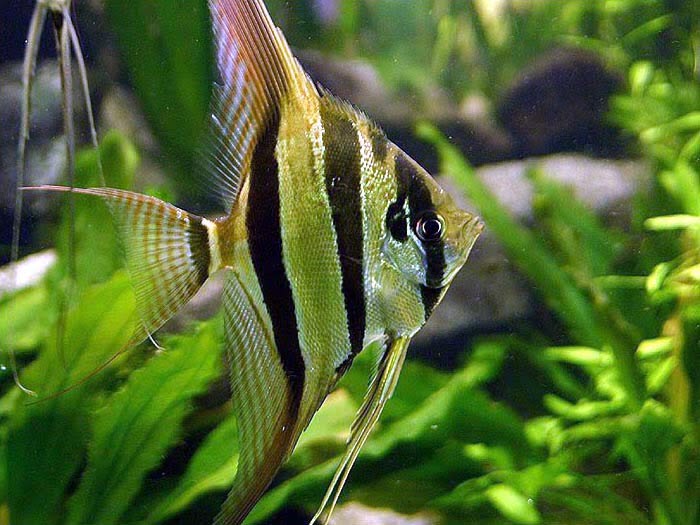
These are the most common type of Angelfish you’ll come across. They are typically silver with black vertical stripes.
Gold Angelfish
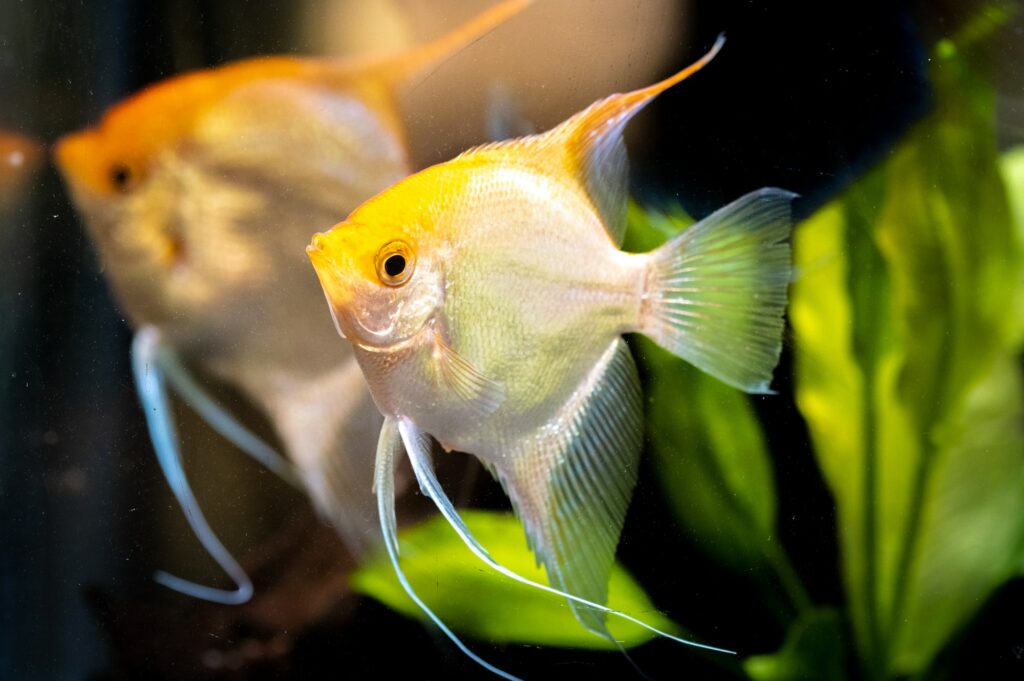
These Angelfish stand out with their completely golden or yellow coloration. They are a sight to behold in a well-lit aquarium.
Marble Angelfish
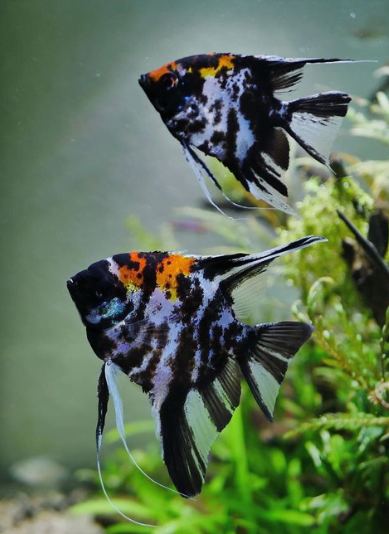
Sporting a black, white, and yellow marbled pattern, these Angelfish are as beautiful as they are unique. The marbling pattern varies, making each fish one-of-a-kind.
Koi Angelfish
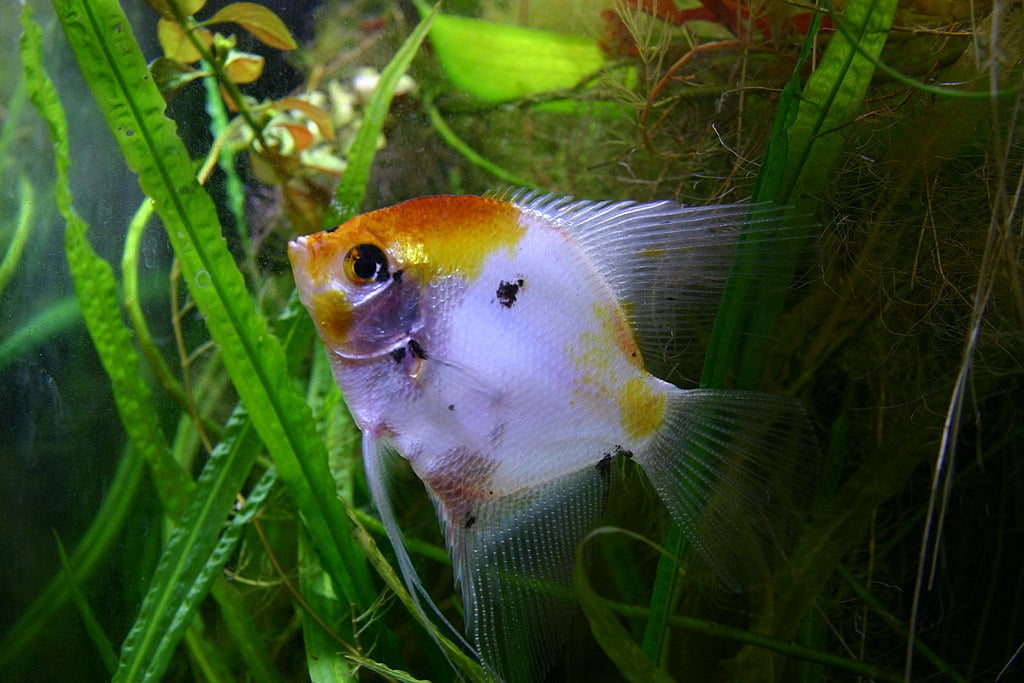
Named after the striking resemblance to Koi fish, these Angelfish typically display a mix of orange, white, and black colors. Their vibrant colors make them a popular choice for aquarists.
Zebra Angelfish
The Zebra Angelfish is named for its more prominent black vertical stripes, reminiscent of a zebra’s pattern. This variant often appears more dramatic and elegant in the aquarium.
Leopoldi Angelfish (Pterophyllum leopoldi)
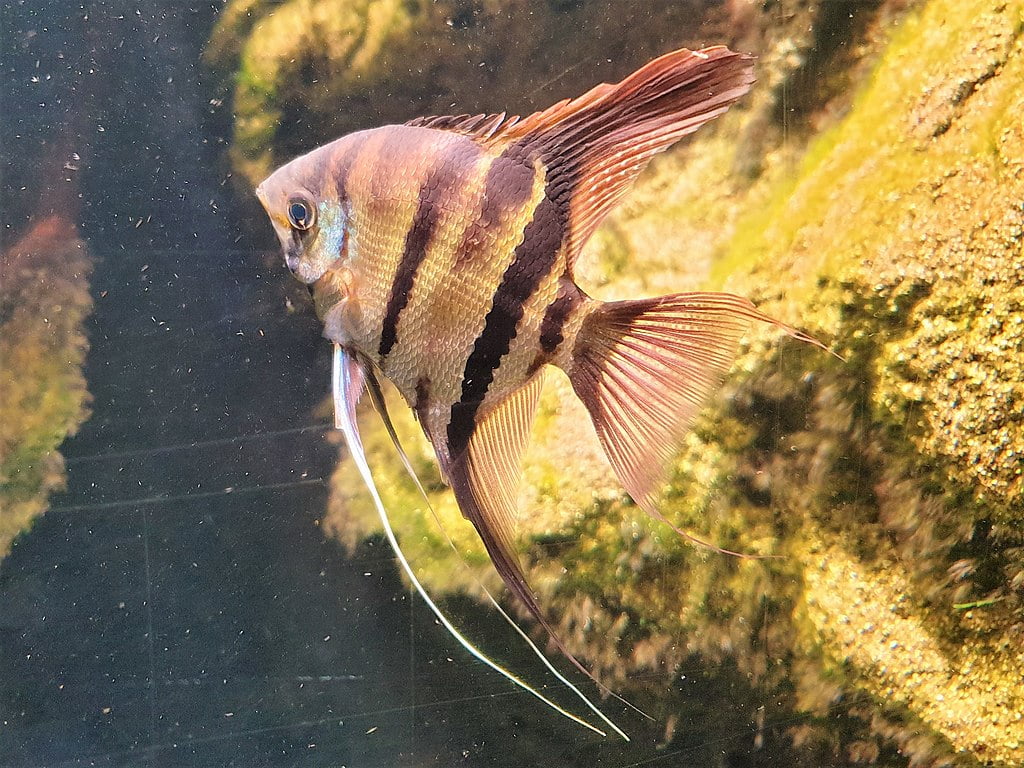
This distinct species is slightly smaller than the others and has a unique shape. Its striking black markings contrast with its lighter body color.
Pearlscale Angelfish
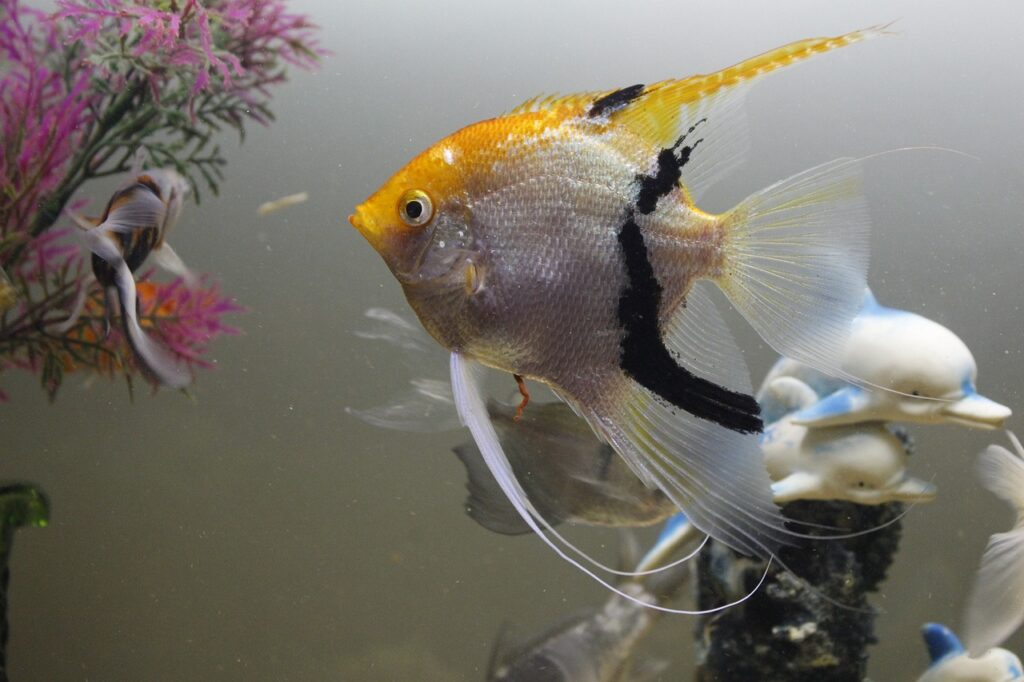
Known for their uniquely textured scales that resemble pearls, these Angelfish often have a shimmering, reflective quality.
Veiltail Angelfish
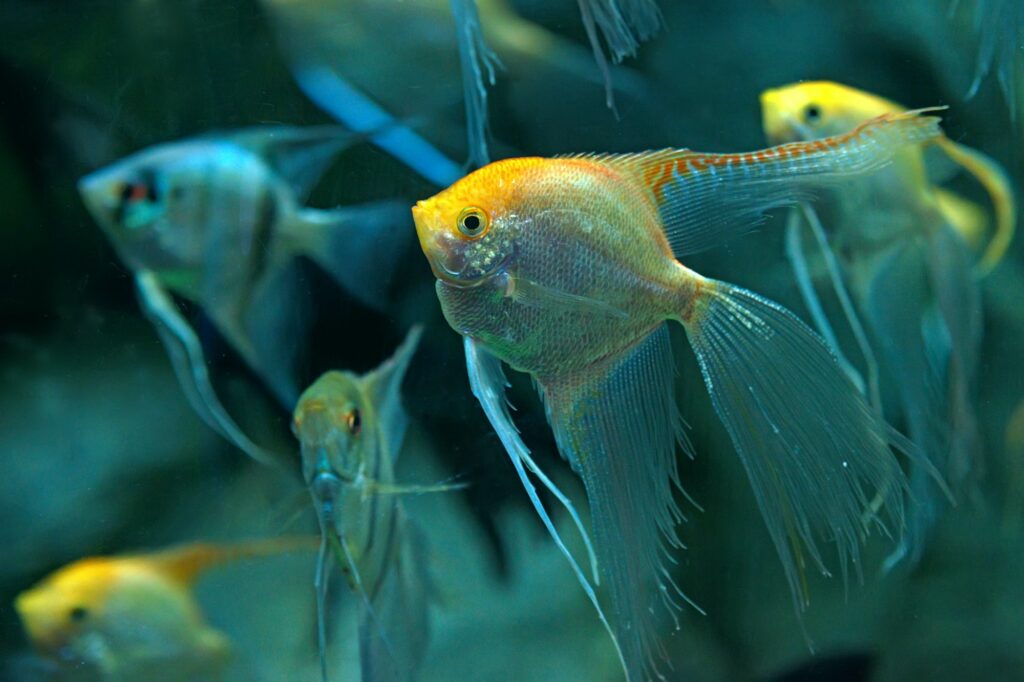
These Angelfish boast long, flowing fins that resemble a veil. They’re highly sought after for their graceful appearance.
Each of these Angelfish variants brings something unique to an aquarium, be it their color, patterns, or body shape. It’s this diversity that makes Angelfish a beloved choice among aquarium enthusiasts.
Creating a Comfortable Home: Recommended Tank Size and Ideal Water Parameters for Angelfish
An essential part of caring for any fish, including the beautiful Angelfish, is ensuring their home – the aquarium – is comfortable and as close to their natural habitat as possible.
Tank Size
First off, let’s talk about tank size. Given that Angelfish can grow up to 6 inches in length and 8 inches in height, it’s important to have an aquarium that gives them plenty of room to swim and grow. A tank that’s too small can lead to stress, poor health, and stunted growth. So, for a single Angelfish, I’d recommend a tank of at least 20 gallons.
However, if you plan on keeping a group, a larger tank of at least 55 gallons will be necessary. Remember, these fishes are tall and wide, so ensure your tank is deep enough for them to swim vertically without their long fins touching the substrate or the surface too much.
Water Parameters
Keeping the right water parameters is crucial to ensure the good health and longevity of your Angelfish. Here are the ideal parameters you should maintain:
- Temperature: Angelfish are tropical fish and thrive in warm water temperatures. The ideal range is between 78 and 82 degrees Fahrenheit (25.5 to 27.7 degrees Celsius).
- pH Level: Angelfish prefer slightly acidic to neutral water. A pH range between 6.0 and 7.5 is suitable.
- Water Hardness: Soft to moderately hard water is best for Angelfish. They can tolerate a general hardness (GH) of 5-13 dGH.
- Ammonia, Nitrite, Nitrate Levels: Like all fish, Angelfish are sensitive to these toxic compounds. It’s important to maintain zero levels of ammonia and nitrites, and nitrates should be kept below 20 ppm. Regular water changes and a good filtration system can help maintain these levels.
- Lighting: Angelfish aren’t too picky about lighting, but they do come from naturally shady environments, so it’s best to provide moderate lighting. If the tank is too bright, make sure there are plenty of plants or decorations where the fish can find shade.
By ensuring the correct tank size and optimal water parameters, you can create a comfortable, stress-free environment that allows your Angelfish to thrive. And believe me, there’s nothing more rewarding than seeing your fish happy and healthy in their aquatic home!
Time and Growth: Angelfish Lifespan and Full Size
When it comes to the lifespan of Angelfish, a well-cared-for specimen can live anywhere from 8 to 10 years in an aquarium environment. Of course, lifespan can be influenced by many factors including diet, water quality, and overall tank conditions. One thing that I’ve found to make a significant difference in Angelfish longevity is regular, partial water changes to maintain a clean and healthy aquarium environment.
Angelfish, as I’ve mentioned earlier, are part of the Cichlidae family, and like many cichlids, they grow to a significant size. So, how big do Angelfish get? Under ideal conditions, a mature Angelfish can reach up to 6 inches in length and an impressive 8 inches in height, counting the long dorsal and anal fins. They have a unique, triangular body shape that sets them apart from many other aquarium fish.
Keep in mind that Angelfish grow relatively quickly during their first 6-12 months of life and will reach their full size by the time they’re about 1.5 to 2 years old. As such, it’s essential to consider their potential size when selecting a tank and arranging it. Your aquarium should be large enough to accommodate full-grown Angelfish comfortably, and decorations should not obstruct their swimming paths.
Also, while Angelfish have hearty appetites, overfeeding can lead to obesity and related health issues. Stick to a feeding schedule and provide a balanced diet to ensure your Angelfish grow healthily and reach their potential size without encountering health problems.
To sum it up, with proper care and maintenance, Angelfish can grow to a good size and live long, healthy lives. In return, they will reward you with their elegant beauty and intriguing behavior for many years. Now, isn’t that a trade-off worth making?
Mirroring Nature: The Natural Environment, Behavior, Habitat Preference, and Ideal Aquarium Decoration for Angelfish
Natural Environment and Habitat Preference
Angelfish originate from the slow-moving freshwater rivers, streams, and floodplains of the Amazon Basin, Orinoco Basin, and various rivers in the Guiana Shield. These environments are generally characterized by dense aquatic vegetation and a soft, sandy bottom. The waters are often tinted brown due to the tannins released from decaying organic matter, giving them a slightly acidic pH.
Behavior
In the wild, Angelfish are semi-aggressive fish that establish territories within their habitat. They are known for their social behavior, often seen in small groups or pairs. Interestingly, these fish are not the fastest swimmers, but they are skilled at navigating through the thick vegetation and other obstructions in their environment.
Ideal Aquarium Decoration
When setting up an aquarium for Angelfish, it’s best to mimic their natural habitat as closely as possible. Here’s how you can do it:
Substrate: Opt for a soft, sandy substrate, reminiscent of their natural river-bottom habitats. This also helps if you’re keeping other species that prefer to burrow.
Plants: Incorporate live plants into your aquarium. They serve a dual purpose, not only do they enhance the aesthetics, but they also provide hiding spots and contribute to maintaining water quality. Some great plant choices include Amazon swords, Java ferns, and Anubias, which can tolerate the warmer temperatures that Angelfish prefer.
Hiding Spots: Provide plenty of hiding spots using driftwood, rocks, and caves. These will help your Angelfish feel safe and secure. Just make sure the decor doesn’t have sharp edges that could damage their delicate fins.
Lighting and Water Flow: Angelfish come from naturally shady environments and aren’t too fond of strong lighting. Moderate lighting is ideal for them. Additionally, since they’re accustomed to slow-moving waters, they prefer a gentle water flow in the aquarium.
By replicating their natural environment and considering their behavioral traits, you can create an ideal and comforting setup that helps your Angelfish thrive. Trust me, a well-planned, nature-inspired aquarium setup will not only contribute to the well-being of your fish but also create a stunning visual spectacle for you to enjoy.
Company for Your Angelfish: Best Tank Mates and Fish to Avoid
Choosing the Best Tank Mates
As an aquarium enthusiast, one of the joys I find is carefully selecting and mixing different species of fish to create a harmonious community tank. When choosing tank mates for your Angelfish, there are a few things to consider: size, temperament, and water condition preferences.
Angelfish can get quite large and have semi-aggressive tendencies, particularly during breeding. Smaller, peaceful fish may become targets, so it’s best to avoid those that are significantly smaller. Also, very active, fast-moving fish may cause stress for the Angelfish.
Here are some ideal tank mates that I’ve found work well with Angelfish:
- Dwarf Gouramis: These are peaceful and brightly colored fish that make an excellent contrast to the Angelfish. They are also similarly sized, reducing the risk of the Angelfish feeling threatened.
- Bristlenose Plecos: Plecos are bottom dwellers and have different feeding patterns, reducing competition for food. They also help keep the tank clean.
- Corydoras Catfish: These fish are peaceful, active, and stay small. They are fast enough to avoid Angelfish and spend most of their time at the bottom of the tank.
- Rummy-nose Tetras: These are schooling fish that add a splash of color to your tank. They are fast swimmers and usually stay out of the way of Angelfish.
- Platies: These are hardy, peaceful fish that can hold their own with Angelfish. They come in various colors, adding diversity to your aquarium.
Fish to Avoid
While it’s exciting to mix and match different fish species, some should be avoided as tank mates for Angelfish. Here are some examples:
- Small, Fin-nipping Species: Angelfish have long, flowing fins that are an easy target for fin-nippers like Tiger Barbs.
- Larger, Aggressive Fish: Fish like Oscars and Jack Dempseys are too aggressive and could harm or stress your Angelfish.
- Fast-moving Fish: Fast-moving and active fish like Danios can stress Angelfish and often outcompete them for food.
Creating a harmonious community aquarium requires careful consideration of the different species’ behaviors, sizes, and temperaments. By choosing the right companions for your Angelfish, you can create a lively, diverse, and peaceful aquarium environment. It’s a bit of a science and an art, but the reward is a beautiful, thriving underwater world right in your living room!
A Hearty Meal: Best Foods and Diet for Angelfish
Feeding your Angelfish a balanced and varied diet is essential for their overall health and color vibrancy. Angelfish are omnivores, meaning they eat both meaty foods and plant matter. In the wild, they feed on a variety of small crustaceans, insect larvae, and vegetation.
So, what should you feed your Angelfish at home? Let’s dig into the best foods and diet plan:
Flake and Pellet Foods
High-quality flakes and pellets designed for tropical fish can form the base of your Angelfish’s diet. These are generally well-balanced nutritionally, and most contain a mix of plant matter and animal proteins.
Live and Frozen Foods
For a protein boost, consider supplementing with live or frozen foods. Brine shrimp, daphnia, and bloodworms are all excellent choices. They not only provide the necessary proteins and nutrients but also help stimulate your Angelfish’s natural hunting instincts.
Vegetable Matter
Angelfish benefit from having some plant matter in their diet. Cooked peas, blanched spinach, and spirulina flakes are all good options.
Feeding Schedule
Feed your Angelfish 2-3 times a day, giving them only as much as they can eat in a couple of minutes. Overfeeding can lead to obesity and water quality issues.
While Angelfish aren’t particularly picky eaters, they do appreciate variety in their diet. Switching up the types of food they get not only ensures they receive a range of nutrients but also keeps mealtime interesting for them.
Expanding the Family: Angelfish Breeding Tips
Breeding Angelfish can be a rewarding experience, allowing you to observe their fascinating courtship behavior and watch the development of new generations. However, it’s not always a straightforward process and requires careful preparation and patience. Here are some key tips that I’ve found helpful in breeding Angelfish successfully.
Maintain a Balanced Male to Female Ratio in Your Tank
Angelfish are monogamous, which means they mate for life. This unique behavior means that once a pair has established a bond, they won’t typically breed with other partners.
So, if you’re interested in breeding Angelfish, you might start with a group of juveniles (5 to 6 individuals), allowing them to naturally pair off as they mature. In this case, the exact male-to-female ratio is less critical because Angelfish have the unique ability to change their sex to ensure the survival of the species. This change usually happens when there is an abundance of one gender.
However, if aggression becomes a problem, increasing the number of females may help. Having more females than males can often diffuse tension as it decreases competition between males.
After pairs are formed, it’s recommended to separate each pair into their own breeding tank to prevent aggression and ensure the safety of eggs and fry. The other fish can cause stress to the breeding pair and might even eat the eggs.
Ensure Your Aquarium Conditions Mimic Their Natural Breeding Environment
Recreating their natural environment in your tank can significantly enhance the chances of successful breeding. As they originate from warm, slow-moving waters, you’ll want to keep the temperature between 78 and 82 degrees Fahrenheit. A slightly acidic pH (6.5-7.0) and softer water can also encourage breeding.
Provide Plenty of Vegetation or Other Surfaces for Them to Lay Eggs On
Angelfish prefer to lay their eggs on a vertical or slightly angled surface. This could be a broad-leaved plant, a piece of slate, or even the aquarium glass. Providing them with a selection of potential egg-laying sites will increase the likelihood of them spawning.
FAQs
How can I distinguish between male and female Angelfish?
Distinguishing between male and female Angelfish can be quite challenging, especially when they are young. Generally, mature males have a more angular head shape, while females tend to have a rounded forehead. During spawning, the female Angelfish has a rounder and thicker breeding tube, while the male’s is pointed and thinner.
Why are my Angelfish fighting?
Angelfish may fight due to competition for resources like food or territory, especially if the tank is overcrowded. It’s also common during breeding times as they can be protective of their mates and eggs. Ensure your tank has plenty of space and hiding spots to minimize aggressive behaviors.
Can Angelfish live alone?
While Angelfish can technically survive alone, they are a social species and often do best in pairs or small groups. However, overcrowding can lead to territorial disputes, so it’s important to provide enough space for each fish.
How many eggs do Angelfish lay?
A female Angelfish can lay anywhere from 100 to 1000 eggs at a time, depending on her age and size. However, not all these eggs will necessarily become viable fry.
Can Angelfish change their gender?
Yes, Angelfish can change their gender, but it’s a rare occurrence and usually happens when there is a significant imbalance of males to females. It’s part of their mechanism to ensure the survival of the species.
What diseases are Angelfish prone to?
Like any other fish, Angelfish can be prone to several diseases if not cared for properly. This includes Ich (white spot disease), fin rot, and hole-in-the-head disease. Maintaining clean water conditions and a balanced diet is the best way to prevent these illnesses.
Do Angelfish need a filter and heater in their tank?
Yes, Angelfish do require a heater and a filter in their tank. The heater helps to maintain the warm temperatures they need, typically between 76 and 82°F. The filter helps to keep the water clean and free from harmful toxins.
How do I acclimate my new Angelfish to my tank?
To acclimate your new Angelfish, float the bag they came in on the surface of your tank for about 15 minutes. This allows the water in the bag to gradually match the temperature of your tank. Then, every five minutes for the next twenty minutes, add a small amount of your tank water to the bag. After that, you can gently release the fish into the tank.
How do Angelfish sleep?
Angelfish, like most fish, don’t sleep in the same way humans do. Instead, they have periods of rest where they remain still and their metabolism slows down. This usually happens when the lights are off, as they follow a day-night cycle similar to ours.
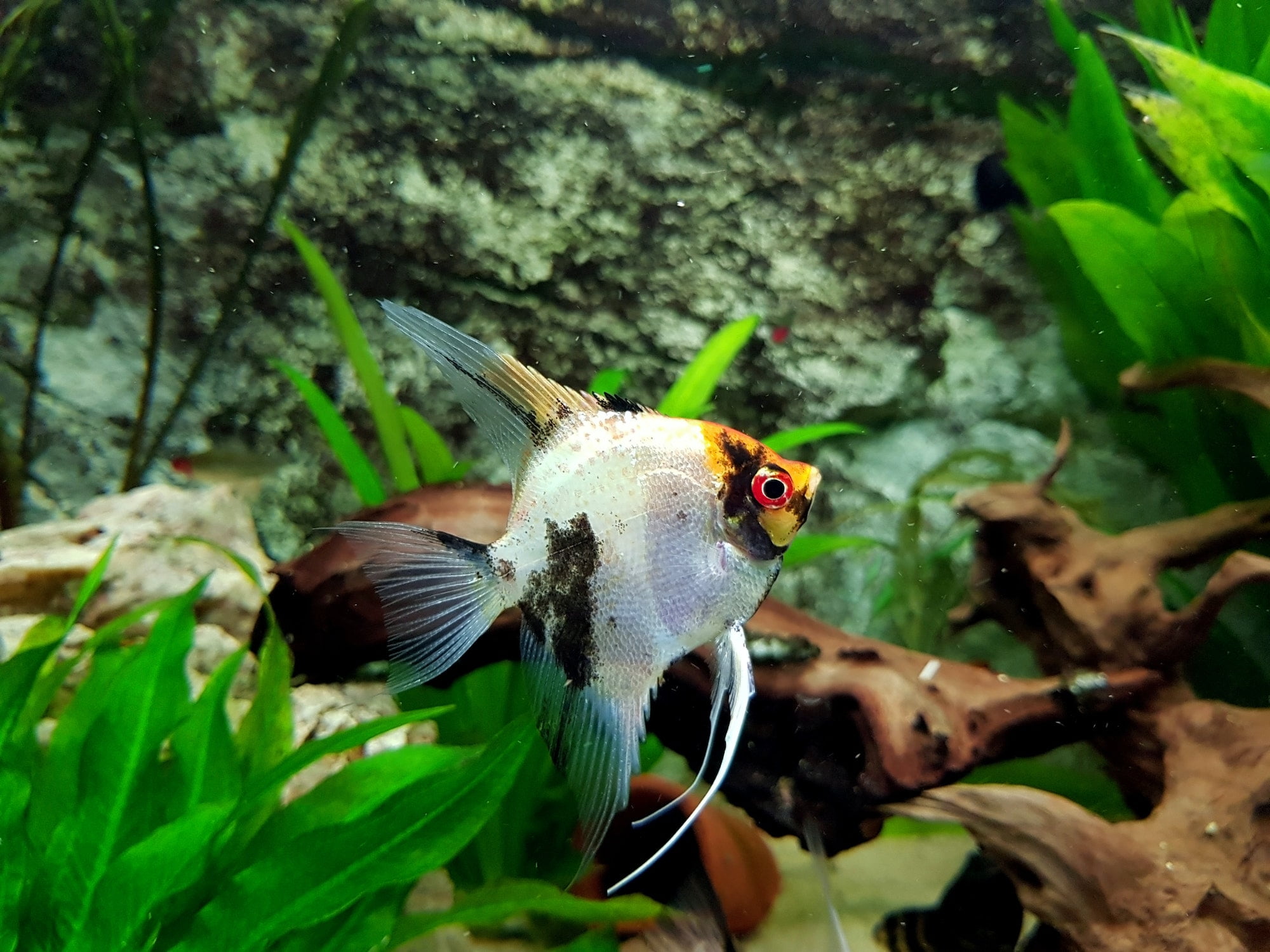
Leave a Reply